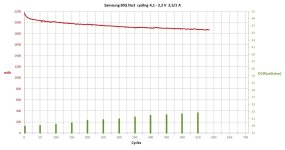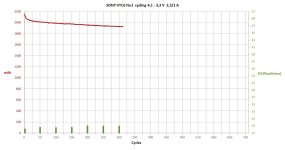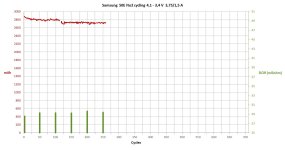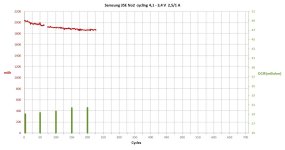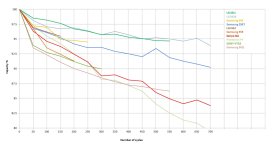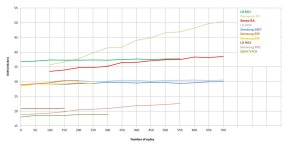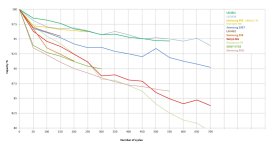eMark
100 kW
Thanks! Maybe, i got a really good BG-8S or i don't have a good enough DMM ... or, maybe because the comparison was at 3.75V ... anyway close enuf for my scientific notation :wink:
Nope sorry just not true.eMark said:If the disparity is as much as 30mV difference between one of the P-groups compared to the other P-groups that are within 10mV of each other it's not only time to balance charge, but there could be more serious problems down the road.
Thanks! Maybe, i got a really good BG-8S or i don't have a good enough DMM or a little of both ... or ... maybe because the comparison was at 3.75V. Anyway close enuf for my scientific notation :wink:docware said:Citation from iSTD BG-8S manual :
„Voltage measurement accuracy : ± 0,005 V @ 4,2 V“
You have to also take into consideration that iSTD unit is supplied from some measured cells – another factor affecting the voltage. Resulting inaccuracy may be 10 – 40 mV, or more, who knows. Until you check the real voltages (first without BG-8S, then with BG-8S connected) with external voltmeter having sufficient resolution 0,1 mV and sufficient input resistance, you have no idea what´s truly going on.
So the voltmeter accuracy is just being human-compared to the reference displayed, no self-calibrating going on?docware said:I decided to use voltage reference MAX6341 also in this single purpose instrument to have all in one.
Padja where are you when i could use your moral supportdocware said:Until you check the real voltages (first without BG-8S, then with BG-8S connected) with external voltmeter having sufficient resolution 0,1 mV and sufficient input resistance, you have no idea what´s truly going on.
john61ct said:If so can the voltmeter be manually calibrated if you see it's drifted?
You do realize that 0,1mV is actually 0,0001V. It isn't necessary to have a DMM that can read 4 places beyond the decimal point to know "what's truly going on". Scientific notation uses a period (not a comma) and generally three digits (e.g. 3.745V) is sufficient. For the purposes of even this ageing thread it's not necessary to know the cell voltage four digits beyond the decimal point ... as you've implied with "0,1mV" (e.g. 3,7453V). Three digits beyond the decimal point is sufficient for ebiker DIY builds when using a quality DMM and Cell Monitor for checking Lithium-ion cell voltages :thumb:docware said:Until you check the real voltages (first without BG-8S, then with BG-8S connected) with external voltmeter having sufficient resolution 0,1 mV and sufficient input resistance, you have no idea what´s truly going on.
eMark said:You do realize that 0,1mV is actually 0,0001V. It isn't necessary to have a DMM that can read 4 places beyond the decimal point to know "what's truly going on".
Realistically, doesn't that "If" become more of a challenge the more P-groups (e.g. 10S4P vs 14S8P) even with top brand name grade A cells as the battery ages.docware said:It is simple. If my paralel groups are within 3 mV, resolution 0,1 mV is must for reliable and repeatable measurement.
Not disagreeing with the need for precise accuracy when testing cells whether by the manufacturer for their datasheet or by you for presenting in this thread. But here's my rub (if a rub) so would appreciate your take (Yes, No, Maybe with brief reasoning) as it possibly deserves further discussion in another thread. So, here goes FWIW ...docware said:Requirement of ten times better resolution than measured values is valid not only for measurement of electrical values, but for measurement of all physical units generally.
eMark said:Realistically, doesn't that "If" become more of a challenge the more P-groups (e.g. 10S4P vs 14S8P) even with top brand name grade A cells as the battery ages.
eMark said:Realistically, doesn't that "If" become more of a challenge the more P-groups (e.g. 10S4P vs 14S8P) even with top brand name grade A cells as the battery ages.
Is it not a legitimate ageing question? Don't see why you think it's "weed infestation."docware said:I again ask administrators to ban this trolling member acces to this thread. eMark is responsible for weed infestation also in other threads, not only this one.
Thank you
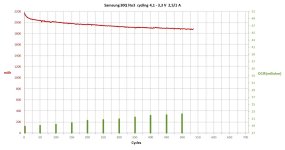
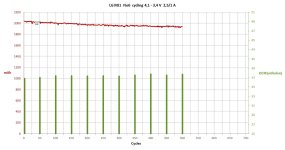
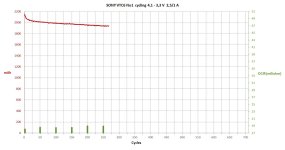
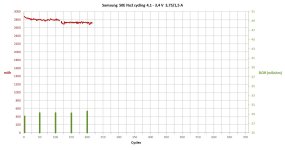
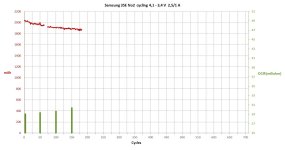
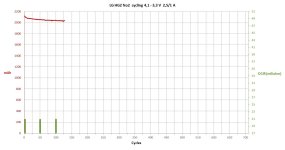
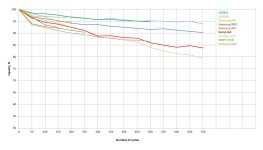

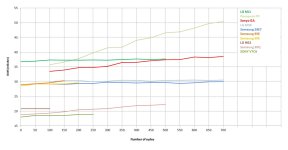

Problem is your questions are often too wordy and just not comprehensible. Besides being needlessly specific and unecessary, argumentative to the point of constituting harassment.eMark said:Realistically, doesn't that "If" become more of a challenge the more P-groups (e.g. 10S4P vs 14S8P) even with top brand name grade A cells as the battery agesdocware said:It is simple. If my paralel groups are within 3 mV, resolution 0,1 mV is must for reliable and repeatable measurement.
Hadn't noticed before, how much the low end of the 30Q data makes obvious there's a very different chemistry there.docware said:
leffex said:.
Pretty weak cell if you ask me(mine were about 1500mah) and I just noticed they commit suicide charged under zero C* conditions ifs cell is higher than 65 m-ohm.
